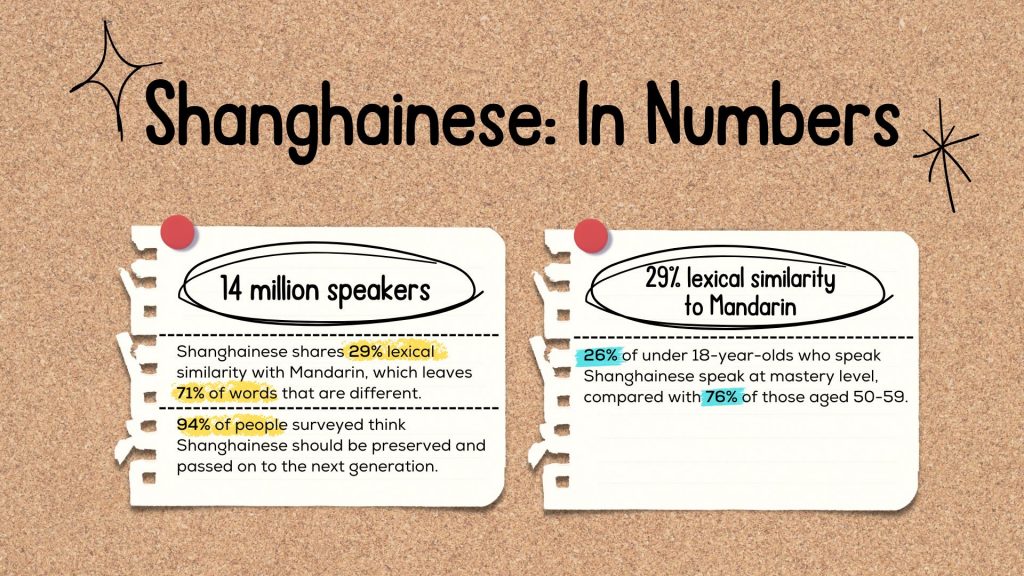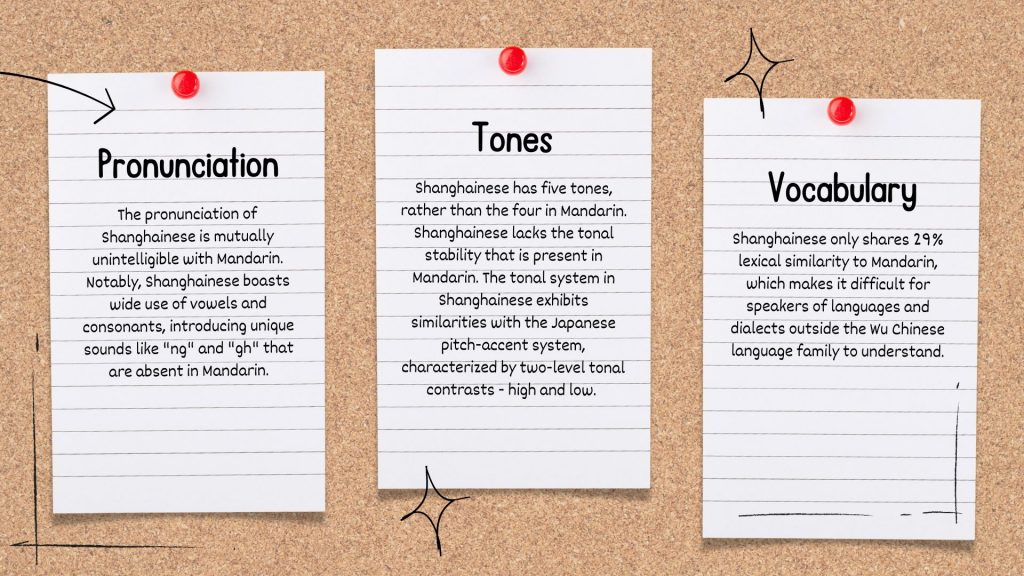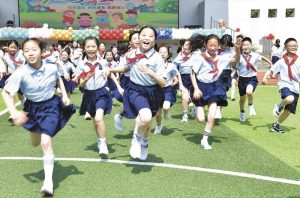
Welcome to an exploration of the linguistic landscape of Shanghai. In this blog, we answer the question “What is Shanghainese?” as we navigate the history of the Shanghainese dialect and its importance in modern-day life in Shanghai. We’ll also explore the differences between Shanghainese vs. Mandarin and provide some tips to make the most of your next language-learning adventure to Shanghai. Ready to get started? Let’s begin!
Did you know? There are over 300 languages and dialects spoken in China!
What is Shanghainese?
Shanghainese, known as 上海话 (Shànghǎi huà) in Mandarin, is a dialect of the Wu Chinese language group. Shanghainese is the third most spoken Chinese language or dialect after Mandarin and Cantonese. Shanghainese is spoken by almost 14 million people and is primarily spoken in the Yangtze River Delta region in China. Despite efforts to promote Mandarin after it became the official language of China in 1949, Shanghainese has seen a resurgence in recent years to protect and reintroduce it into the education system. At one point, it was feared that the Shanghainese dialect could disappear completely within the next 50 years.
Shanghainese: In Numbers
Before we dive in, let’s explore some of the key facts and figures of the Shanghainese dialect, with its past, present and potential trends in the future.
- 14 million speakers. There are 14 million speakers of Shanghainese globally. It is the third most spoken language or dialect in China.
- 29% lexical similarity to Mandarin. Shanghainese shares 29% lexical similarity with Mandarin, which leaves 71% of words that are different. These are often basic, everyday words, which adds to the difficulty of learning Shanghainese.
- Young people prefer Mandarin when speaking to elder relatives. 22% of under 18-year-olds who speak Shanghainese would use it when speaking to elders. 50% would choose Mandarin.
- Declining numbers of young speakers. 26% of under 18-year-olds who speak Shanghainese speak at mastery level, compared with 76% of those aged 50-59.
- Cultural significance and future growth. 94% of people surveyed think Shanghainese should be preserved and passed on to the next generation.

Shanghainese vs. Mandarin
The key differences between Shanghainese and Mandarin are in pronunciation, tones and vocabulary. Shanghainese and Mandarin share overlapping vocabulary and grammatical structures and are both written using simplified Chinese characters (汉字 – Hànzì). Let’s expand on what makes Shanghainese different from Mandarin.
- The pronunciation of Shanghainese is mutually unintelligible with Mandarin. Notably, Shanghainese boasts wide use of vowels and consonants, introducing unique sounds like “ng” and “gh” that are absent in Mandarin.
- Shanghainese has five tones, rather than the four in Mandarin. Shanghainese lacks the tonal stability that is present in Mandarin. The tonal system in Shanghainese exhibits similarities with the Japanese pitch-accent system, characterized by two-level tonal contrasts – high and low. These are referred to as yin (阴 – yīn) and yang (阳 – yáng) tones.
- Shanghainese only shares 29% lexical similarity to Mandarin. This makes it difficult for speakers of languages and dialects outside the Wu Chinese language family to understand.

Shanghainese vs. Cantonese
Shanghainese and Cantonese are very different from each other and are not mutually intelligible. Shanghainese is a member of the Wu Chinese language group, whereas Cantonese exists within the Yue dialect group. There are also key differences in vocabulary and grammar. To highlight this, Shanghai (where Shanghainese is spoken) is over 1,200 kilometres from Guangzhou (where Cantonese is spoken) as the crow flies. This demonstrates the vast geography of China and the range of historical and cultural diversity that shape its linguistic landscape.
Is Shanghainese Difficult to Learn?
While learning Shanghainese is certainly a challenge, it can provide a rich opportunity for passionate language learners to expand their horizons. If you want to communicate like a local in Shanghai or the surrounding areas, don’t discount the value of studying the Shanghai dialect! Here’s some key factors that influence the difficulty of learning Shanghainese.
- Language exposure. Shanghainese is primarily spoken in the city of Shanghai and its surrounding regions. For learners outside of this area, finding opportunities to immerse themselves in the Shanghai dialect can be a challenge. Language exposure is vital to learn Shanghainese.
- Mandarin understanding helps. Shanghainese and Mandarin share some linguistic elements (29% lexical similarity), so an understanding of Mandarin language helps when studying Shanghainese. That said, to learn Shanghainese will require dedicated and consistent effort over a sustained period.
- Lack of resources. Another challenge for learners of Shanghainese is the scarcity of educational resources. Unlike Mandarin, Shanghainese lacks comprehensive textbooks, courses and online learning apps to aid study.
- Romanization of Shanghainese. Shanghainese is written using Chinese characters, which have a romanization system called Pinyin. While Pinyin is widely used for Mandarin, Shanghainese Pinyin is less standardized. This lack of consistency in romanization can pose a challenge for learners who do not have prior study experience of other Chinese language and dialects.
- Mixing languages. In everyday communication, it’s not uncommon for Shanghainese speakers to mix their native dialect with Mandarin or other Chinese languages and dialects. Shanghai’s nature as a modern, cosmopolitan city of over 26 million makes it a melting pot for different languages and dialects.
Languages and Dialects in Shanghai
The three most commonly spoken languages in Shanghai are Mandarin (95%), Shanghainese (54%) and English (7%). These are also the languages that are used on public transport in Shanghai. Other languages that are used in Shanghai include Cantonese, Manchu and other foreign languages such as French and Spanish. Each of these languages and dialects have helped to shape Shanghai into the globalized city it is today. In Shanghai, Mandarin is much more widely spoken than the Shanghainese dialect, which is predominantly spoken by Shanghai indigenous residents or people who have lived in Shanghai over a sustained period.
Is Shanghainese a Language or Dialect?
Shanghainese is a dialect within the Wu Chinese language group. While Shanghainese shares commonalities with Mandarin, the official language of China, its regional specificity and unique linguistic features contribute to its classification as a dialect rather than a language.
A History of the Shanghainese Dialect
The first documentation of the Shanghainese dialect was published by foreign missionaries in the late 1800s. Shanghai is often considered the poster city for modern-day China and is strategically positioned at the mouth of the Yangtze River. This makes it a key global strategic trading port. During the Qing Dynasty (1644–1912), Shanghai transformed from a modest fishing village into a flourishing international trading hub. This era played a key role in the development of the Shanghainese dialect. In 1949, the Chinese government made Mandarin the official language in China. As a result of this, use of the Shanghainese dialect went into decline. In recent years, there have been significant efforts in to reinvigorate the use and study of Shanghainese.
Shanghainese in Modern-Day Shanghai
The prominence of Mandarin as the national language meant that the use and study of the Shanghainese dialect was discouraged in formal educational settings from 1992. Visit Shanghai today and you will find most young people speaking either Mandarin or a mixture of Shanghainese and Mandarin. According to a recent survey, only 26% people under 18 in Shanghai speak Shanghainese fluently, which is significantly lower than the 60% of Mandarin speakers aged 30-35.
Efforts to Revitalize Shanghainese
Shanghainese is not frequently used in formal settings, including in business. It is also not widely used on social media. In recent years, the preservation efforts of Shanghainese have seen some success, with an increasing number of TV programs embracing Shanghainese and other Chinese languages and dialects. Shanghainese has also been more widely used in music and popular culture to combat the dominance of Mandarin and Cantonese. There are also radio stations dedicated to the use of Shanghainese in their broadcasts. In another response to the decline of the use of Shanghainese, former Shanghai opera actress Ma Lili passionately campaigned for the protection of Shanghainese. More recently, Shanghainese politicians have advocated for the increased use of Shanghainese in the city and surrounding regions, including in more formal settings.
Do I Need to Learn Shanghainese to Live in Shanghai?
Other than an interest in Chinese languages and dialects, there is no need to learn Shanghainese to live in Shanghai. Mandarin, the official language of China, suffices for daily communication in the city. If you are living in Shanghai (or planning to), learning the Shanghainese dialect can help you to strengthen connections and cultural integration within the city. Ultimately, the decision to learn the Shanghainese dialect relies on your personal goals and aspirations.
Conclusion
An understanding of the history and development of Shanghainese opens a window into life in Shanghai and the surrounding regions. Despite the dominance of Mandarin as the official national language, the resurgence of the Shanghainese dialect in recent years paints a hopeful picture for the future. With its distinct pronunciation, tonal system and vocabulary, Shanghainese presents a unique opportunity for language learners with an interest in Chinese languages and dialects to broaden their horizons. If you are up for a language-learning challenge, Shanghainese may be the way to go!
FAQs
- How does Shanghainese differ from Mandarin? Shanghainese differs from Mandarin in pronunciation, tones and vocabulary. Shanghainese has five tones, rather than the four in Mandarin and only shares 29% lexical similarity with Mandarin.
- Is Mandarin sufficient for communication in Shanghai? As Mandarin is the official language of China, knowledge of Mandarin is suitable for everyday life in Shanghai.
- How widely is Shanghainese spoken in Shanghai? While Shanghainese is spoken by 54% of the population in Shanghai, Mandarin remains the dominant language and is spoken by 95% of residents.
- Is Shanghainese a language or a dialect? Shanghainese is a dialect within the Wu Chinese language group.
- Is Shanghainese difficult to learn? Learning Shanghainese presents challenges, including limited language exposure, the absence of current and accessible resources, and the mixing of Chinese languages and dialects in everyday communication.
- Are there resources available for learning Shanghainese? Learning resources for Shanghainese are limited compared to Mandarin. There are some textbooks geared towards the study of Shanghainese, however they are small in number and there is also a lack of online language learning tools and apps.
- Should I learn Shanghainese if I’m planning to live in Shanghai? Unless you have a specific interest in Chinese languages and dialects, there is no need to learn Shanghainese to live in Shanghai.
- Is Shanghainese used in formal or business settings in China? Shanghainese is not commonly used in formal settings or when conducting business in China. Mandarin remains the preferred language for formal interactions.
Author:
Sean speaking to students at Beths Grammar School about his experience of learning Chinese, living in China and founding Newsdle and The Chairman’s Bao.
Sean studied Chinese and Spanish at University of Leeds and founded The Chairman’s Bao alongside Tom Reid in his final year of study in 2015. Current Managing Director of The Chairman’s Bao, he has overseen the company’s growth from university bedroom concept to an international force in the EdTech industry with over 200,000 individual users and over 400 global partner institutions. Sean also launched Newsdle alongside Tom Reid and Oliver Leach in 2021, for students and teachers of Spanish and French. In his spare time, Sean is still a keen language learner and runner. He also sits on the Board of charity Leeds Irish Health and Homes in the UK.
Sean McGibney


























